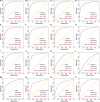Incidence, Risk Factors, and Outcomes of Severe Hypoxemia After Cardiac Surgery
- PMID: 35837609
- PMCID: PMC9273816
- DOI: 10.3389/fcvm.2022.934533
Incidence, Risk Factors, and Outcomes of Severe Hypoxemia After Cardiac Surgery
Abstract
Background: Hypoxemia is common in patients undergoing cardiac surgery, however, few studies about severe hypoxemia (SH) after cardiac surgery exist. The objectives of this study were to clarify the incidence, risk factors, and outcomes of SH after cardiac surgery.
Methods: Patients undergoing cardiac surgery from 2016 to 2019 in a single center were enrolled and were divided into two groups based on whether postoperative SH developed. Independent risk factors for SH were identified by univariate and multivariate analysis. Model selection statistics were applied to help determine the most parsimonious final model.
Results: Severe hypoxemia developed in 222 of the 5,323 included patients (4.2%), was associated with poorer clinical outcomes. Six independent risk factors for SH after cardiac surgery were identified by multivariate analysis, such as surgical types, white blood cell (WBC) count, body mass index (BMI), serum albumin, cardiopulmonary bypass (CPB) time, and intraoperative transfusion of red blood cells (RBCs). After comprehensively considering the discrimination, calibration, and simplicity, the most appropriate and parsimonious model was finally established using four predictors, such as WBC count, BMI, CPB time, and intraoperative transfusion of RBCs. A nomogram and a web-based risk calculator based on the final model were constructed to facilitate clinical practice. Patients were stratified into three risk groups based on the nomogram and clinical practice.
Conclusion: Severe hypoxemia was common after cardiac surgery and was associated with poorer clinical outcomes. A parsimonious final model with good discrimination, calibration, and clinical utility was constructed, which may be helpful for personalized risk assessment and targeted intervention.
Keywords: cardiac surgery; hypoxemia; nomogram; prediction model; risk factor.
Copyright © 2022 Wang, Ding, Su, Yang, Du, Sun, Huang, Yue, Sun, Xie and Liu.
Conflict of interest statement
The authors declare that the research was conducted in the absence of any commercial or financial relationships that could be construed as a potential conflict of interest. The reviewer SL declared a shared parent affiliation with the authors XCD and YS at the time of review.
Figures



References
LinkOut - more resources
Full Text Sources

